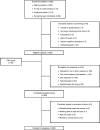Factors associated with (risk of) undernutrition in community-dwelling older adults receiving home care: a cross-sectional study in the Netherlands
- PMID: 26923753
- PMCID: PMC10270920
- DOI: 10.1017/S1368980016000288
Factors associated with (risk of) undernutrition in community-dwelling older adults receiving home care: a cross-sectional study in the Netherlands
Abstract
Objective: It is generally thought that causes of undernutrition are multifactorial, but there are limited quantitative studies performed. We therefore examined a wide range of potential factors associated with undernutrition in community-dwelling older adults.
Design: Cross-sectional study.
Setting: Community-dwelling older adults (≥65 years) receiving home care in the Netherlands.
Subjects: Data on potential factors associated with (risk of) undernutrition were collected among 300 older adults. Nutritional status was assessed by the SNAQ65+ instrument. Undernutrition was defined as mid-upper arm circumference <25 cm or unintentional weight loss of ≥4 kg in 6 months. Being at risk of undernutrition was defined as having poor appetite and inability to walk up and down stairs of fifteen steps, without resting.
Results: Of all participants, ninety-two (31·7 %) were undernourished and twenty-four (8·0 %) were at risk of undernutrition. Based on multivariate logistic regression analyses, the statistically significant factors associated with (risk of) undernutrition (P<0·05) were: unable to go outside (OR=5·39), intestinal problems (OR=2·88), smoking (OR=2·56), osteoporosis (OR=2·46), eating fewer than three snacks daily (OR=2·61), dependency in activities of daily living (OR=1·21), physical inactivity (OR=2·01), nausea (OR=2·50) and cancer (OR=2·84); a borderline significant factor was depression symptoms (OR=1·83, P=0·053).
Conclusions: The study suggests that (risk of) undernutrition is a multifactorial problem and that associated factors can be found in several domains. These findings may support the development of intervention trials for the prevention and treatment of undernutrition in community-dwelling older adults.
Keywords: Community-dwelling; Cross-sectional; Mid-upper arm circumference; Older adults; Weight loss.
Figures
References
-
- Chen CC, Schilling LS & Lyder CH (2001) A concept analysis of malnutrition in the elderly. J Adv Nurs 36, 131–142. - PubMed
-
- Meijers JM, van Bokhorst-de van der Schueren MA, Schols JM et al.. (2010) Defining malnutrition: mission or mission impossible? Nutrition 26, 432–440. - PubMed
-
- Phillips MB, Foley AL, Barnard R et al.. (2010) Nutritional screening in community-dwelling older adults: a systematic literature review. Asia Pac J Clin Nutr 19, 440–449. - PubMed
-
- Lee JS, Kritchevsky SB, Tylavsky F et al.. (2005) Weight change, weight change intention, and the incidence of mobility limitation in well-functioning community-dwelling older adults. J Gerontol A Biol Sci Med Sci 60, 1007–1012. - PubMed
MeSH terms
LinkOut - more resources
Full Text Sources
Other Literature Sources
Medical


